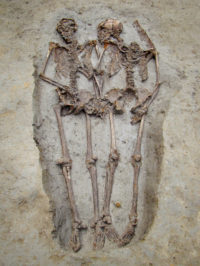 A new study has discovered that the famed Lovers of Modena are two men, not a man and woman as previously the believed. The couple found buried hand-in-hand in a 6th century necropolis in Modena, northern Italy, in 2009 were initially thought to be male and female based on osteological examination of the bones, but the remains were not in very poor condition and that initial assessment has now been conclusively shown to be erroneous by a new technique analyzing the peptides on tooth enamel.
A new study has discovered that the famed Lovers of Modena are two men, not a man and woman as previously the believed. The couple found buried hand-in-hand in a 6th century necropolis in Modena, northern Italy, in 2009 were initially thought to be male and female based on osteological examination of the bones, but the remains were not in very poor condition and that initial assessment has now been conclusively shown to be erroneous by a new technique analyzing the peptides on tooth enamel.
The site in a suburb of Modena (Roman Mutina) was not originally a cemetery. The earliest layer has remains of Roman buildings, most notably a calcara, workshops where limestone was fired in kilns to produce lime for mortar. Ten feet above that the necropolis begins with 11 burials. A third layer, separated from the second by a thick alluvial silt deposit believed to have been caused by a flood of the Tiepido river, contains seven graves but they were all empty, believed to have been dug right before a major flood in 589 and never occupied.
The double burial was in the second layer. The head of the individual believed to be female was facing its companion, while the other was looking away. His vertebrae indicate the head was rotated after burial, so he was probably facing his gravemate in the beginning and shifted, perhaps in one of the Tiepido floods. Their hand position was not the result of random post-burial shifting. The individual initially identified as male had the palm of his left hand facing up. The individual initially identified as female had his right hand placed palm down inside the hand of his comrade.
There only artifacts found in the grave was a bronze ring next to the body believed to be male. It indicated the man was a cives romanus (Roman citizen). All of the graves in this layer were very modest, simple trenches dug in the ground with the bodies buried in the bare earth.
Because the bones were in such bad condition, DNA could not be extracted. Researchers employed a new technique that analyzes the proteins in dental enamel. The individual believed to be female had AMELY (amelogenin, Y-linked) in his enamel proteome, a gene that encodes the amelogenin protein that is only found in the Y chromosome. AMELY was also found in the second skeleton, by the way, confirming that he was indeed male.
His youth (he was around 20 years old when he died) played a role in the subtle presentation of the sexually dimorphic features. There are very few pre-modern burials in which adult couples are buried in an embrace, and of those few, none of them (before now) was known to be male-male. Between that, the age of the deceased, the condition of the bones and the fact that the bodies were deliberately buried holding hands, the idea that this was a heterosexual romantic couple.
There is no explicit evidence of a romantic relationship between the two men and indeed it’s highly unlikely that in the Christian culture of Late Antiquity male lovers would be buried hand-in-hand to reflect that relationship. Sex between men was prohibited by law starting in the early 5th century and religiously proscribed long before then. Nonetheless, the holding of hands is an expression of connection and commitment. Several of the bodies unearthed at the necropolis bear weapons-related injuries, so it’s possible it was a war cemetery and the “Lovers” were actually fighters, comrades who died together in battle and were therefore interred together. They could also have been close relatives.
The study has been published in the journal Nature and can be read here.
A touching story. I keep saying this but as much as I am grateful we find these things I always feel a bit sad that these two people are probably now stacked
away in a box or two n some anonymous building rather than being together as they have been for 1500 years though
They may have been close companions, who died at the same time, but it’s not out of the question that they were brothers.